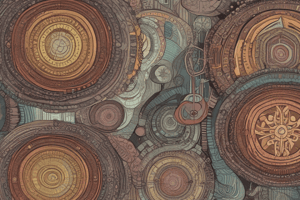Podcast
Questions and Answers
What is color fastness in textiles?
What is color fastness in textiles?
- The process of dyeing textiles
- The property of textiles to reflect light
- The resistance of the color of textiles to various agents (correct)
- The texture of textiles after washing
What is the purpose of the Grey Scale in color fastness tests?
What is the purpose of the Grey Scale in color fastness tests?
- To measure the texture of the textile
- To assess the quality of the dye used
- To visually evaluate changes in color of textiles (correct)
- To determine the color of the textile
What is fastness to sublimation?
What is fastness to sublimation?
- Resistance to light
- Resistance to washing
- Resistance to the transition of a solid directly to a gas (correct)
- Resistance to rubbing
Why is color fastness an important quality feature of textile products?
Why is color fastness an important quality feature of textile products?
What is the rating scale used to assess color fastness?
What is the rating scale used to assess color fastness?
What is the difference between color fastness to washing and color fastness to perspiration?
What is the difference between color fastness to washing and color fastness to perspiration?
What is the purpose of the Grey Scale in evaluating color changes?
What is the purpose of the Grey Scale in evaluating color changes?
What does a high color fastness grade indicate?
What does a high color fastness grade indicate?
What is the difference between color fastness to light and color fastness to rubbing?
What is the difference between color fastness to light and color fastness to rubbing?
What is the range of the Grey Scale used in color fastness tests?
What is the range of the Grey Scale used in color fastness tests?
Flashcards are hidden until you start studying
Study Notes
Fiber Properties
- Presence of acetate side chains in acetate fibers makes them softer and easier to work with than cotton, but provides fewer binding sites for dye molecules.
- Nylon is a polyamide made up of hydrocarbon repeating units joined together by highly polar amide functional groups, providing sites for hydrogen bonding to dye molecules.
- Polyester repeating units are joined together by ester functional groups.
Forces of Attraction in Dyeing
- Four types of forces of attraction or bond are at work in dyeing: ionic bonds, covalent bonds, hydrogen bonding, and Van Der Waals forces.
- Ionic bonds: interaction between negative center of dye with positive center of fiber and vice versa.
- Covalent bonds: actual chemical bond between fiber and dye through crosslinkage agents such as 2,4,6-trichloro triazine (reactive dye).
- Hydrogen bonding: primarily electrostatic force of attraction between hydrogen atom covalently bound to electronegative atom or group, and another electronegative atom bearing a lone pair of electrons.
- Van Der Waals forces: due to interaction between π-orbitals of dye and fiber, very weak forces.
Dye Classes' Color Fastness Properties
- Direct dyes: moderate washing, moderate light, good dry cleaning, good perspiration, good rubbing.
- Disperse dyes: good washing, good light, good dry cleaning, good perspiration, good rubbing.
- Reactive dyes: good washing, good light, excellent dry cleaning, excellent perspiration, good rubbing.
- Vat (except indigo) dyes: excellent washing, excellent light, good dry cleaning, excellent perspiration, good rubbing.
- Azoic dyes: good washing, good light, moderate dry cleaning, good perspiration, moderate rubbing.
Textile Fibers Classification
- Protein fibers: wool is a protein made up of amino acid repeating units with acidic or basic side chains that are ionized (charged), providing excellent binding sites for dye molecules.
- Cotton is a polysaccharide composed of glucose units with three polar hydroxyl groups per glucose repeating unit, providing multiple sites for hydrogen bonding to ionic and polar groups in dye molecules.
- Acetate fibers: cellulose with some –OH groups replaced by acetate groups (–OCOCH3).
Color Fastness
- Color fastness: resistance of the color of textiles to different agents during manufacture and use.
- Common color fastness tests: washing, light, sublimation, perspiration, and rubbing.
- Assessment of color fastness: uses Grey Scale to assess changes in color and staining, with ratings from 1 (poor) to 5 (excellent).
Studying That Suits You
Use AI to generate personalized quizzes and flashcards to suit your learning preferences.




